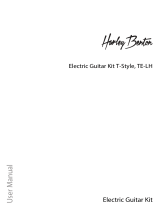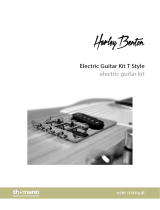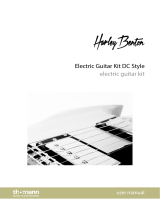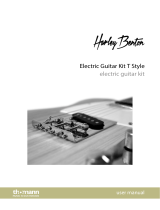Page is loading ...

Electric Guitar Kit ST Style
electric guitar kit
user manual

Musikhaus Thomann
Thomann GmbH
Hans-Thomann-Strasse 1
96138 Burgebrach
Germany
Telephone: +49 (0) 9546 9223-0
E-mail: [email protected]
Internet: www.thomann.de
05.01.2021, ID: 185163

Table of contents
1 Safety instructions................................................................................................................. 4
2 Scope of delivery..................................................................................................................... 5
3 Assembly instructions.......................................................................................................... 6
3.1 Cut the headstock to size............................................................................................. 6
3.2 Painting the body and neck........................................................................................ 7
3.3 Mounting the tuners...................................................................................................... 8
3.4 Mounting the string retainers.................................................................................. 10
3.5 Mounting the bridge................................................................................................... 11
3.6 Wiring the potentiometers, pickups and switches........................................... 13
3.7 Mounting the pickguard and output jack socket.............................................. 15
3.8 Mounting the neck of the guitar............................................................................. 17
3.9 Mounting the strap buttons..................................................................................... 19
3.10 Strings, neck relief, string height and pickups................................................. 20
4 Protecting the environment........................................................................................... 25
Table of contents
Electric Guitar Kit ST Style
3

1 Safety instructions
DANGER!
Danger for children
Ensure that plastic bags, packaging, etc. are properly disposed of and
are not in the reach of babies and young children. Choking hazard!
Ensure that children do not detach any small parts (e.g. knobs or the
like) from the product. They could swallow the pieces and choke!
Never let children play unattended with the product.
CAUTION!
Danger of cuts on the hands
While assembling and joining individual parts together with screws pay
attention to sharp edges on tools, screws and components.
Safety instructions
electric guitar kit
4

2 Scope of delivery
Thank you for buying this guitar kit. All the wood, hardware and electrical compo‐
nents of the guitar are contained in this package.
The picture below shows the individual items included in the delivery.
The assembly is described in detail in the following sections.
Scope of delivery
Electric Guitar Kit ST Style
5

3 Assembly instructions
Provide the following tools and materials for the assembly of the guitar:
n Phillips screwdriver
n Rubber mallet
n Ring spanner
n Pliers
n Paint and accessories
n Sandpaper
It is important to paint the body and neck before assembly.
Always wear a dust mask when applying spray paint.
3.1 Cut the headstock to size
Cut the headstock to your desired shape using a suitable saw. Ensure you leave su‐
cient space between the cutting edge and the holes for the tuners to maintain sta‐
bility. The tuners' retaining rings should be used as a reference here.
After cutting, smooth the cutting edge with sandpaper or a suitable le.
Useful tools and materials
Assembly instructions
electric guitar kit
6

3.2 Painting the body and neck
The solid wood body of the guitar is sealed and prepared for various types of lacquer
coating. A wide variety of nishes can be procured from DIY, timber and automotive
outlets in aerosol cans making nishing straightforward without requiring specialist
skills.
The rst step is to check the t of the body to the neck joint. These components are
machined from high-grade tonewoods to ensure optimum alignment. Since wood is
a natural material, however, its shape changes slightly over time. If the t is too tight,
you can adjust it using a sharp chisel or sandpaper. Please remember that the addi‐
tional lacquer coat will make the neck t a little more tightly into the cutout.
Before coating the body, ensure that all surfaces are clean and free of dirt and dust.
Carry out all painting operations in a well-ventilated, dust-free environment. Consid‐
ered and careful working are key factors for a qualitatively satisfactory result. We
explicitly recommend that you rst try out the colour and technique on another
piece of wood.
Paint the body edges rst and let them dry. If the edges are dry, go on with front and
back side. By layered, successive application you can achieve a uniform coating struc‐
ture. If you notice surface irregularities, wait until the paint has dried completely and
correct them with ne sandpaper (e.g. 800+) before proceeding to paint. For full cov‐
erage apply three or more layers.
Insert a wire or hook into the cutout for the guitar neck and hang the painted guitar
body to dry in a dry, dust-free area away from direct sunlight.
Wait another two to three days until the paint is fully cured. Polish or burnish the
body until it meets your expectations. Take care not to bu too vigorously as this
may remove the nish.
The neck of the guitar is sealed at the factory with a thin layer of matt lacquer and is
already ready to use. However, if you would still like to treat the neck with paint or
clear lacquer, follow the instructions below.
Carefully mask o the ngerboard and all frets before you start painting. Make sure
that all surfaces are free of dust and dirt. Carry out all painting operations in a well-
ventilated, dust-free environment.
Use a clear or lightly coloured wood lacquer of high quality for the neck. Start on the
front and the edges of the headstock. Apply a thin layer evenly, allow it to dry and
repeat this two or three times. If you notice surface irregularities, wait until the paint
has dried completely and correct them with ne sandpaper (e.g. 800+) before pro‐
ceeding to paint.
Once the headstock has dried, place the neck on the ngerboard and paint the back
of the neck as described.
Wait another two to three days until the paint is fully cured. Polish or burnish the
neck until it meets your expectations. Take care not to bu too vigorously as this may
remove the nish.
Painting the body
Neck nish
Assembly instructions
Electric Guitar Kit ST Style
7

3.3 Mounting the tuners
From the rear side of the headstock, insert the tuners into the holes provided. Align
the tuners so that the tuning pins are vertical to the upper edge of the headstock.
Fasten the tuners in this position as shown in the picture, initially fastening them
only nger-tight with the screws provided.
Turn the neck and fasten all the machine heads nger-tight to the front of the head‐
stock with the washers and nuts provided.
Assembly instructions
electric guitar kit
8

Tighten the nuts on the front with an appropriate spanner, then tighten the screws
on the back rmly to fasten the tuners.
Assembly instructions
Electric Guitar Kit ST Style
9

3.4 Mounting the string retainers
Ax the two string retainers to the front of the head plate in the holes provided next
to the tuners. The string retainer with the larger spacer must be inserted into the hole
that is closer to the saddle.
Ensure the string retainers can still move freely. They will be secured by the tension
of the strings.
Assembly instructions
electric guitar kit
10

3.5 Mounting the bridge
Place the body on a suitable working surface. Use a soft pad in order to avoid
damage to the surface. Place the bridge in the cutout on the body as shown, and
guide the sustain block into the hole through the body.
Ensure the bridge sits in the centre of the hole and is aligned with the pre-drilled
screw holes. Attach the bridge using the supplied screws.
Assembly instructions
Electric Guitar Kit ST Style
11

Next, turn the body around and screw the spring claw by hand into the pre-drilled
screw holes in the cutout on the body's back.
Attach the loops of the three springs to the spring claw and guide the other ends
into the small holes in the sustain block. Continue to tighten the spring claw towards
the neck until some tension is applied to the bridge.
Assembly instructions
electric guitar kit
12

3.6 Wiring the potentiometers, pickups and switches
The potentiometers, pickups and switches are pre-assembled on the pickguard and
simply need to be connected to the output jack socket and earth. The pickups,
potentiometer and jack socket are wired to the output jack socket by means of con‐
nectors.
As illustrated, run the cable connector into the cable channel via the recess as far as
the recess for the output jack socket.
Assembly instructions
Electric Guitar Kit ST Style
13

Thread the cable for the string earthing (after stripping the insulation, and without
the connector) to the spring claw through the recess in the opening on the back.
Hook the grounding cable onto the spring claw. Ensure there is sucient contact
between the stripped end of the earthing wire and the spring claw.
Assembly instructions
electric guitar kit
14

3.7 Mounting the pickguard and output jack socket
Position the pickguard over the front of the body so that the pickups and all the
wires are seated in the correct recesses. Screw the pickguard onto the body using the
screws provided as shown in the picture below.
Assembly instructions
Electric Guitar Kit ST Style
15

Now connect the connector for the output jack socket to the connector for the
pickup and the potentiometers. Insert the output jack socket into the hole provided
on the body's front side and screw it in place using the screws provided.
Assembly instructions
electric guitar kit
16

Then screw the plastic plate which covers the recess for the sustain block into place
by inserting the screws provided into the pre-drilled holes on the back of the body.
3.8 Mounting the neck of the guitar
Place the body on a suitable working surface. Use a soft pad in order to avoid
damage to the surface. Insert the neck into the neck cutout. If necessary, use a sharp
chisel or sandpaper to adjust it. Be very careful when removing material. The neck
should be rmly seated and under no circumstances should there be too much play
in the cutout!
Assembly instructions
Electric Guitar Kit ST Style
17

Turn the guitar over and position the neck plate over the four bolt holes at the rear of
the body, then screw the four wood screws provided through the neck plate, body
and pilot holes in the neck until everything ts tightly.
Assembly instructions
electric guitar kit
18

3.9 Mounting the strap buttons
Screw the strap buttons into the pre-drilled holes in the body as shown.
Assembly instructions
Electric Guitar Kit ST Style
19

3.10 Strings, neck relief, string height and pickups
Fitting strings to the guitar is achieved by threading them through the sustain block
from the rear to the front via the corresponding saddle. Wrap the string end around
the tuner several times and pull each string hand-tight at rst. Be sure that each
string is in the correct position on the saddle and in the correct string retainer.
Stringing the guitar
Assembly instructions
electric guitar kit
20
/






